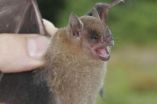(Press-News.org) STANFORD, Calif. — Consider the marvel of the embryo. It begins as a glob of identical cells that change shape and function as they multiply to become the cells of our lungs, muscles, nerves and all the other specialized tissues of the body.
Now, in a feat of reverse tissue engineering, Stanford University researchers have begun to unravel the complex genetic coding that allows embryonic cells to proliferate and transform into all of the specialized cells that perform myriad biological tasks.
A team of interdisciplinary researchers took lung cells from the embryos of mice, choosing samples at different points in the development cycle. Using the new technique of single-cell genomic analysis, they recorded what genes were active in each cell at each point. Though they studied lung cells, their technique is applicable to any type of cell.
"This lays out a playbook for how to do reverse tissue engineering," said Stephen Quake, PhD, the Lee Otterson Professor in the School of Engineering and a Howard Hughes Medical Institute investigator.
The researchers' findings are described in a paper published online April 13 in Nature. Quake, who also is a professor of bioengineering and of applied physics, is the senior author. The lead authors are postdoctoral scholars Barbara Treutlein, PhD, and Doug Brownfield, PhD.
The researchers used the reverse-engineering technique to study the cells in the alveoli, the small, balloon-like structures at the tips of the airways in the lungs. The alveoli serve as docking stations where blood vessels receive oxygen and deliver carbon dioxide.
Treutlein and Brownfield isolated 198 lung cells from mouse embryos at three stages of gestation: 14.5 days, 16.5 days and 18.5 days (mice are usually born at 20 days). They also took some lung cells from adult mice.
They used standard enzymatic techniques to dissolve the proteins that hold the lung cells together in tissue form, then sorted out the specific alveolar cell types that were the focus of their study.
Their next steps involved newer techniques at the heart of their reverse-engineering process.
Recall how eyedroppers work. Squeeze the rubber bulb to evacuate the air; plunge it into a solution to fill it with fluid; squeeze the bulb again to force the fluid out. In recent years, biotechnologists have used those basic principles to develop microfluidic devices of such precision that they can suck a single cell out of solution and isolate it in a chamber to study its genetic material.
Quake's lab has pioneered the use of microfluidic devices to study single cells. In this study, they used microfluidic devices to capture their 198 sample lung cells. Then they used single-cell genomic sequencing to measure which genes were active in each cell at each time.
How did they decode genomic activity in a single cell? DNA in the nucleus of every cell contains the full genome for that organism. That's why it's possible to build an organism from a single cell. But only some of those genes are active in any given cell at any given time. That's why lung cells are different than hair cells; each cell has a different set of active genes directing its functions.
Genes direct cellular activity by making or "expressing" messenger RNA. Each mRNA instructs the cell to make a particular protein. Cells are essentially a group of interacting proteins. Therefore knowing which mRNAs are active offers a lens into the function of that cell at the point when it was captured in the microfluidic device.
Using this process the Stanford researchers revealed for the first time precisely which genes regulate the development of these particular lung cells at each step along the way to mature alveoli.
One important finding involved the development of two key cell types at the tip of the alveoli, where the lung meets blood to perform the gas exchange that keeps us alive.
Alveolar type-1 cells are the flattest cells in the body. Blood cells dock alongside them to deliver oxygen or pick up carbon dioxide. The thinness of the cell is vital to facilitating this gas transfer.
Alveolar type-2 cells are compact and cuboidal. They secrete proteins to keep the alveoli from collapsing like empty balloons, so as to maintain the inner space through which oxygen and carbon dioxide can move.
Using single-cell genomics allowed the researchers to reverse engineer the development process to show how a single progenitor cell type gives rise to both of these different, mature alveolar cells.
The researchers also captured cells in transition from the progenitor to mature cell state, gaining crucial insights into the mechanism of alveolar cell differentiation.
Although this study focused on lung cells, the technique — capturing individual cells at different stages of embryonic development and assessing gene activity through mRNA sequencing — can be used to reverse-engineer other tissues.
In addition to studying embryonic development, the technique could be used in clinical settings. For instance, researchers could study differences between individual cells in a tumor, improving our understanding of the stages of cancers and leading to better, more targeted therapies.
"This technology represents a quantal leap forward in our ability to apprehend the full diversity of cell types in a given population, including rare ones that could have special functions," said Tushar Desai, MD, MPH, assistant professor of pulmonary and critical care medicine at Stanford and co-author of the paper. "Because a comprehensive molecular characterization of each type is achieved, including the signals they send and receive, a snapshot of the communication between individual cells will also emerge and may suggest attractive therapeutic targets in disease."
INFORMATION:
The other Stanford co-authors of the paper are Mark Krasnow, MD, PhD, professor of biochemistry and an HHMI investigator; postdoctoral scholar Angela Wu, PhD; Norma Neff, PhD, genomics core director in the Department of Bioengineering; research assistant Gary Mantalas; and F. Hernan Espinoza, PhD, an HHMI research specialist.
The research was supported by the National Heart Lung and Blood Institute, the National Institutes of Health, the Parker B. Francis Foundation and the Howard Hughes Medical Institute.
The work was also supported by the Department of Bioengineering, which is jointly operated by the School of Engineering and the School of Medicine.
The Stanford University School of Medicine consistently ranks among the nation's top medical schools, integrating research, medical education, patient care and community service. For more news about the school, please visit http://mednews.stanford.edu. The medical school is part of Stanford Medicine, which includes Stanford Hospital & Clinics and Lucile Packard Children's Hospital Stanford. For information about all three, please visit http://stanfordmedicine.org/about/news.html.
The Stanford School of Engineering has been at forefront of innovation for nearly a century, creating pivotal technologies and businesses that have transformed the worlds of technology, medicine, energy and communications and laid the foundation for Silicon Valley. The school advances modern science and engineering through teaching and research. The school is home to nine departments, 245 faculty and more than 4,000 students, tackling the world's most pressing problems in areas like human health and environmental sustainability. For more information, visit http://engineering.stanford.edu.
Print media contact: Tom Abate at (650) 736-2245 (tabate@stanford.edu)
Broadcast media contact: M.A. Malone at (650) 723-6912 (mamalone@stanford.edu)
Stanford scientists develop 'playbook' for reverse engineering tissue
2014-04-16
ELSE PRESS RELEASES FROM THIS DATE:
Red moon at night; stargazer's delight
2014-04-16
Monday night's lunar eclipse proved just as delightful as expected to those able to view it. On the East Coast, cloudy skies may have gotten in the way, but at the National Science Foundation's National Optical Astronomy Observatory (NOAO) near Tucson, Ariz., the skies offered impressive viewing, as seen from the pictures provided here.
Nicknamed a "blood moon," this lunar eclipse's color was similar to the majority of lunar eclipses. This has to do with the Earth's atmosphere's propensity for longer-wavelength light (e.g., the reds, oranges and yellows seen in sunrises ...
Information storage for the next generation of plastic computers
2014-04-16
Inexpensive computers, cell phones and other systems that substitute flexible plastic for silicon chips may be one step closer to reality, thanks to research published on April 16 in the journal Nature Communications.
The paper describes a new proposal by University of Iowa researchers and their colleagues at New York University for overcoming a major obstacle to the development of such plastic devices—the large amount of energy required to read stored information.
Although it is relatively cheap and easy to encode information in light for fiber optic transmission, ...
Two new species of yellow-shouldered bats endemic to the Neotropics
2014-04-16
Lying forgotten in museum collections two new species of yellow-shouldered bats have been unearthed by scientists at the American Museum of New York and The Field Museum of Natural History and described in the open access journal ZooKeys. These two new additions to the genus Sturnira are part of a recent discovery of three bats hidden away in collections around the world, the third one still waiting to be officially announced.
Up until recently the genus Sturnira was believed to contain only 14 species. In the last years closer morphological and molecular analysis have ...
Researchers: Obesity can amplify bone and muscle loss
2014-04-16
TALLAHASSEE, Fla. – Florida State University researchers have identified a new syndrome called "osteosarcopenic obesity" that links the deterioration of bone density and muscle mass with obesity.
"It used to be the thinking that the heavier you were the better your bones would be because the bones were supporting more weight," said Jasminka Ilich-Ernst, the Hazel Stiebeling Professor of Nutrition at Florida State. "But, that's only true to a certain extent."
The syndrome, outlined in the May issue of Ageing Research Reviews, explains how many obese individuals experience ...
Researchers develop a new drug to combat the measles
2014-04-16
A novel antiviral drug may protect people infected with the measles from getting sick and prevent them from spreading the virus to others, an international team of researchers says.
Scientists from the Institute for Biomedical Sciences at Georgia State University, the Emory Institute for Drug Development and the Paul-Ehrlich Institute in Germany developed the drug and tested it in animals infected with a virus closely related to one that causes the measles. As reported in the current issue of the journal Science Translational Medicine, virus levels were significantly ...
Celldex's Phase 1 study of CDX-1401 published in Science Translational Medicine
2014-04-16
HAMPTON, NJ (April 16, 2014): Celldex Therapeutics, Inc. (NASDAQ: CLDX) announced today that final data from its Phase 1 study of CDX-1401 in solid tumors, including long-term patient follow-up, have been published in Science Translational Medicine (Vol 6 Issue 232). The data demonstrate robust antibody and T cell responses and evidence of clinical benefit in patients with very advanced cancers and suggest that CDX-1401 may predispose patients to better outcomes on subsequent therapy with checkpoint inhibitors. CDX-1401 is an off-the-shelf vaccine consisting of a fully ...
Meteorites yield clues to red planet's early atmosphere
2014-04-16
Geologists who analyzed 40 meteorites that fell to Earth from Mars unlocked secrets of the Martian atmosphere hidden in the chemical signatures of these ancient rocks. Their study, published April 17 in the journal Nature, shows that the atmospheres of Mars and Earth diverged in important ways very early in the 4.6 billion year evolution of our solar system.
The results will help guide researchers' next steps in understanding whether life exists, or has ever existed, on Mars and how water—now absent from the Martian surface—flowed there in the past.
Heather Franz, ...
Mutant protein in muscle linked to neuromuscular disorder
2014-04-16
Sometimes known as Kennedy's disease, spinal and bulbar muscular atrophy (SBMA) is a rare inherited neuromuscular disorder characterized by slowly progressive muscle weakness and atrophy. Researchers have long considered it to be essentially an affliction of primary motor neurons – the cells in the spinal cord and brainstem that control muscle movement.
But in a new study published in the April 16, 2014 online issue of Neuron, a team of scientists at the University of California, San Diego School of Medicine say novel mouse studies indicate that mutant protein levels ...
Study provides crucial new information about how the ice ages came about
2014-04-16
An international team of scientists has discovered new relationships between deep-sea temperature and ice-volume changes to provide crucial new information about how the ice ages came about.
Researchers from the University of Southampton, the National Oceanography Centre and the Australian National University developed a new method for determining sea-level and deep-sea temperature variability over the past 5.3 million years. It provides new insight into the climatic relationships that caused the development of major ice-age cycles during the past two million years.
The ...
Searching for dark energy with neutrons
2014-04-16
All the particles we know to exist make up only about five per cent of the mass and energy of the universe. The rest – "Dark Matter" and "Dark Energy" – remains mysterious. A European collaboration lled by researchers from the Vienna University of Technology has now carried out extremely sensitive measurements of gravitational effects at very small distances at the Institut Laue-Langevin (ILL) in Grenoble. These experiments provide limits for possible new particles or fundamental forces, which are a hundred thousand times more restrictive than previous estimations.
Undiscovered ...





